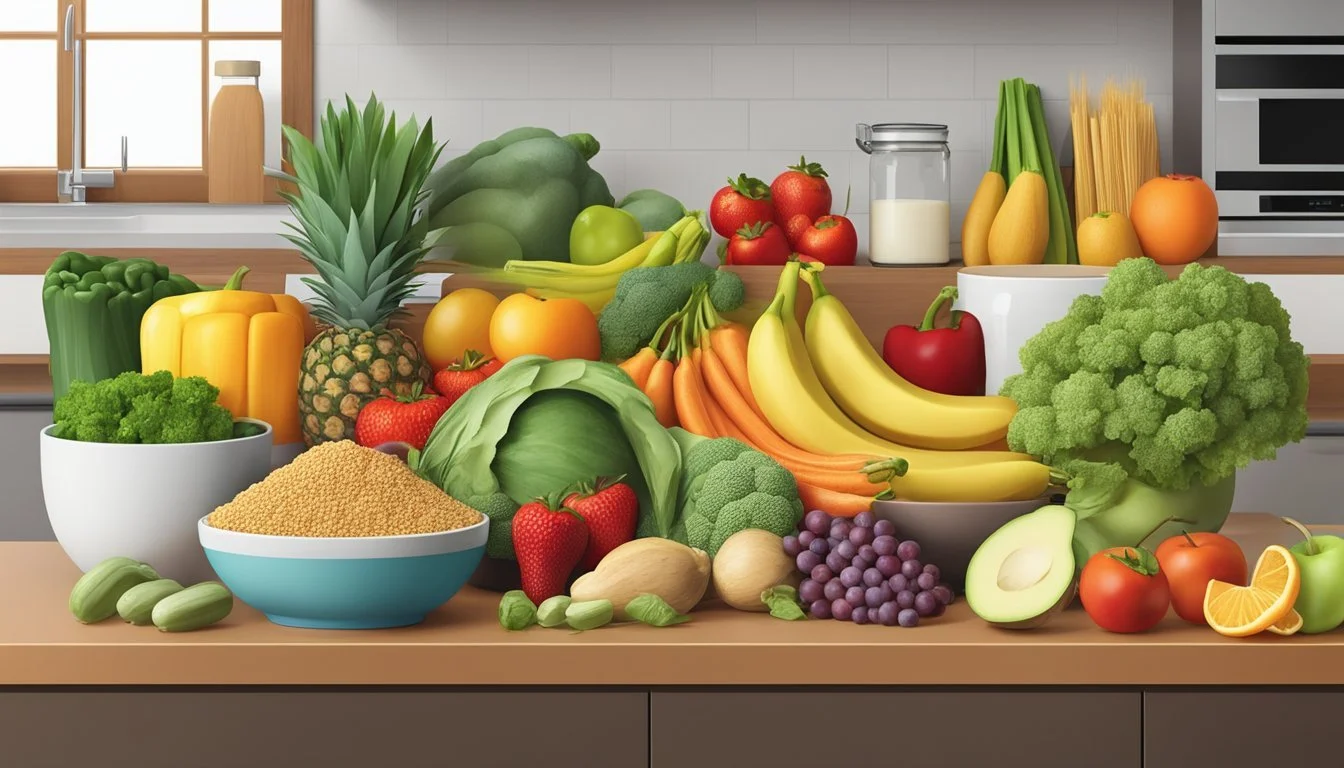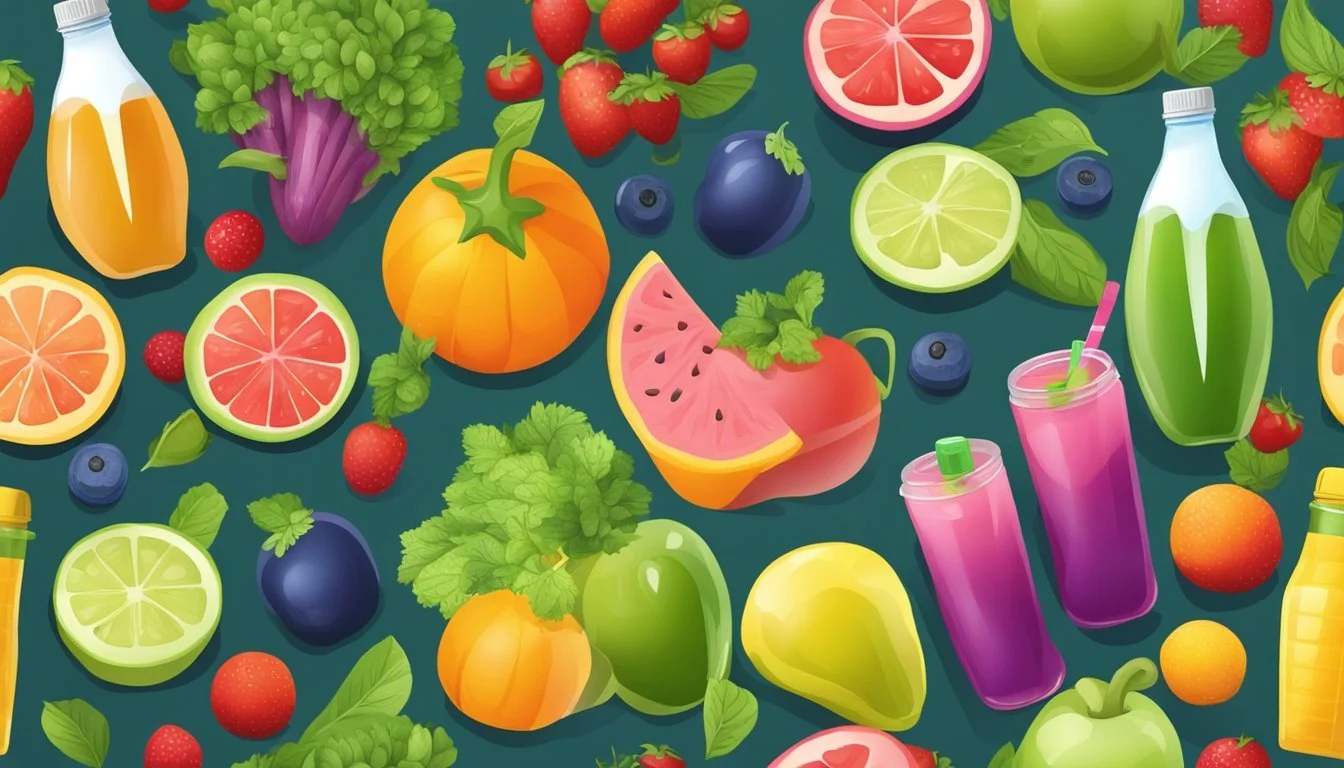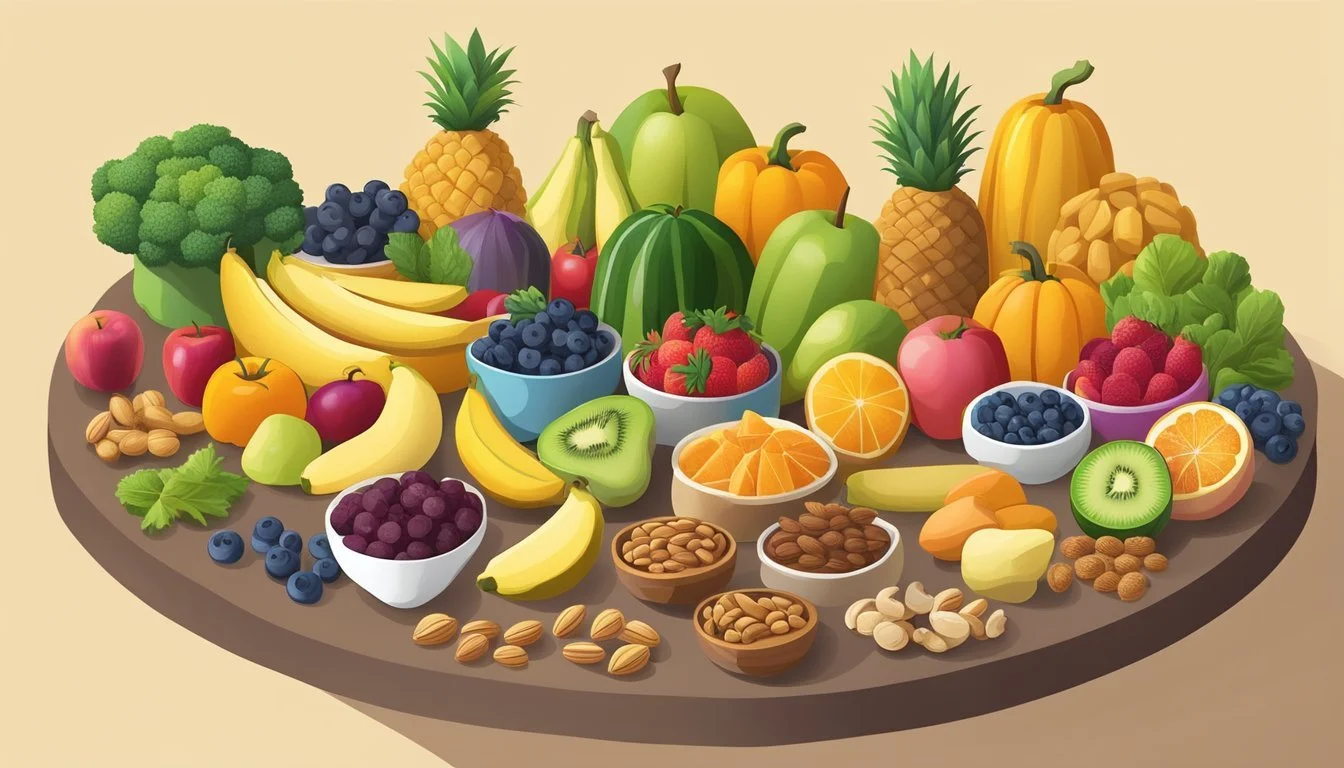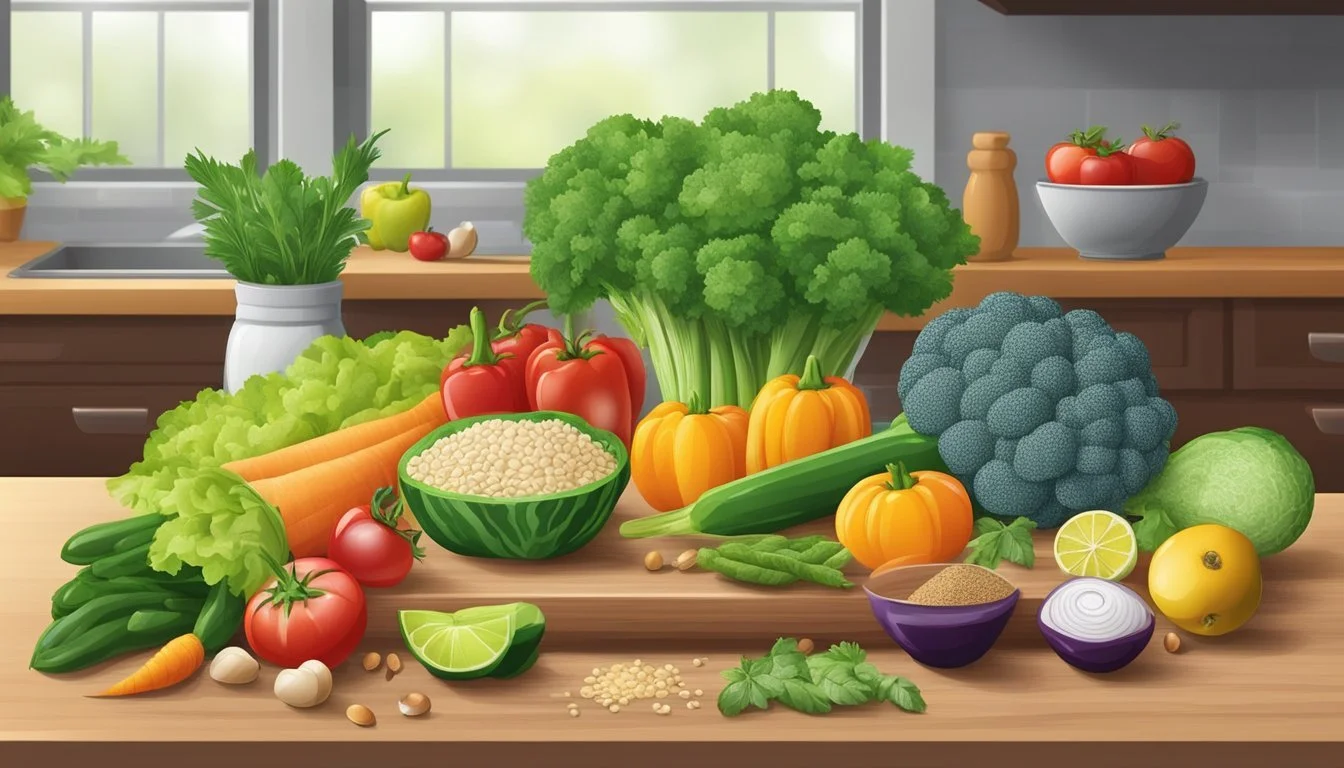Best Foods for a Balanced Meal Prep Plan
Your Essential Guide
Meal prep is the process of planning and preparing meals in advance, which can be an invaluable strategy for those looking to maintain a balanced diet. It aligns with the goal of meeting nutrition needs while adhering to any specific dietary restrictions. By investing time to plan out meals for the week, individuals can ensure they're consuming a variety of nutrients essential for maintaining good health. Not only does meal prep contribute to a healthier lifestyle, but it also simplifies the daily routine, potentially reducing the temptation to opt for less nutritious, convenience foods.
When embarking on meal prep, it's important to consider personal nutrition goals and any medical conditions that might influence dietary choices. Consulting with a healthcare provider can provide tailored guidance to navigate these considerations effectively. Integrating a diverse range of foods, portioning meals appropriately, and staying mindful of balance in macro and micronutrients makes meal planning a customized tool for health management. It benefits those seeking structure in their eating habits, offering an organized approach to nourishing the body.
Healthy meal prep involves incorporating a mix of protein, carbohydrates, and fats, as well as vitamins and minerals found in fruits, vegetables, whole grains, and healthy fats. This practice is not just about adhering to a strict diet; it's about creating a sustainable, enjoyable approach to eating. Thoughtful meal prep ensures that individuals have healthy options readily available, reducing the need for decision-making throughout the week and supporting long-term health and wellness goals.
The Importance of Proteins in Meal Prep
Protein is essential for muscle repair, growth, and overall health. An effective meal prep plan ensures a steady protein intake throughout the day, making meals both satisfying and nutritionally complete.
Incorporating Lean Proteins
Lean proteins such as chicken salad, grilled chicken, tuna, and salmon provide substantial nutrients without excess fats. Shredded chicken and ground turkey are versatile and can be used in various recipes. They serve as an excellent base for meals due to their high protein content and low levels of saturated fat.
Grilled Chicken: Rich in protein, perfect for salads and bowls.
Tuna: Offers Omega-3 fatty acids and serves as a quick protein addition.
Protein-Packed Breakfast Ideas
Starting the day with a protein-rich breakfast can help maintain energy levels and curb cravings.
Eggs: Packed with protein, they can be prepared in numerous ways for breakfast.
Greek yogurt: A creamy protein source that pairs well with nuts and fruit.
Here's a simple list of breakfast items rich in protein:
Scrambled eggs with spinach
Greek yogurt with almonds and berries
Omelet with lean ham and cheese
Vegetarian Sources of Protein
Vegetarian protein sources often come from legumes, nuts, and dairy products like Greek yogurt. These foods are not only high in protein but also offer fiber, healthy fats, and essential vitamins and minerals.
Legumes: Beans, lentils, and chickpeas are versatile legume options.
Nuts: A handful of nuts can be an easy snack providing protein and healthy fats.
A well-rounded vegetarian protein inclusion might look like:
Lentil soup with mixed vegetables
Chickpea salad with a variety of nuts and seeds
Maximizing Nutritional Value with Vegetables
Incorporating a variety of vegetables into meal prep is essential for achieving a balanced diet while maximizing nutritional intake, with emphasis on color, variety, and incorporating them into every meal.
Creating Colorful Salads
Salads are a staple in meal prep as they incorporate a multitude of vibrant and nutrient-dense vegetables. Leafy greens, such as spinach and kale, serve as rich bases, packed with vitamins A and C, iron, and calcium. Adding raw, chopped broccoli to salads includes a boost of vitamin K and folate. For crunch and visual appeal, one can mix in a variety of peppers—red, yellow, and green—each bringing a suite of antioxidants and vitamin C.
Beneficial Breakfast Vegetables
Vegetables should not be confined to lunch and dinner as they make a powerful addition to the first meal of the day. Sautéed spinach or mushrooms can be added to omelets for a kick of iron and selenium. For a sweeter approach, shredded zucchini can be incorporated into oatmeal bakes alongside fruits, delivering fiber and potassium.
Snacking on Veggies
For snacks that are as satisfying as they are nutritious, one might choose raw green beans or broccoli florets, which can be prepped in advance and are ideal for dipping in hummus or a Greek yogurt-based dip. Both options deliver fiber and a range of vitamins while supporting sustained energy levels throughout the day.
Complex Carbohydrates for Energy
Complex carbohydrates are key to sustained energy throughout the day, providing the body with a stable source of fuel for physical and mental activities.
Whole Grains Essentials
Whole grains are a fundamental component of a balanced meal prep plan. They are rich in fiber and contain vitamins and minerals essential for health. Brown rice and quinoa stand out among whole grains for their exceptional nutritional profiles.
Brown Rice: A versatile grain that can easily be incorporated into various meals, providing a good amount of manganese which is crucial for energy production.
Quinoa: Known as a complete protein, it contains all nine essential amino acids alongside a hefty dose of fiber, making it an excellent choice for energy.
Other whole grain options such as oats are beneficial for a breakfast that kick-starts the day. Oatmeal, specifically, can help in maintaining blood sugar levels, reducing the risk of energy spikes and crashes.
Starchy Vegetables as Carbs
Starchy vegetables, particularly sweet potatoes, offer a dense source of carbohydrates and a variety of nutrients.
Sweet Potatoes: They are high in beta-carotene, vitamins, and minerals, and their complex carbohydrates release energy steadily, unlike simple carbs.
Incorporating starchy vegetables into a meal prep plan provides not just energy but also fiber, aiding in digestion and prolonging satiety.
Managing Meal Sizes and Servings
Proper management of meal sizes and servings is essential to meeting nutrition goals, respecting dietary restrictions, and maintaining a balanced diet. This includes understanding the role of calories and fats and determining the balanced servings required for each meal.
Understanding Calories and Fats
Calories are the unit of energy that is obtained from foods. An individual’s calorie needs can vary based on factors such as age, gender, weight, height, and activity level. Healthy fats, which are unsaturated fats, are a necessary component of a balanced diet and should be included in appropriate amounts. Healthy fats include:
Monounsaturated fats: found in olive oil, avocados, and certain nuts.
Polyunsaturated fats: which include omega-3 and omega-6 fatty acids, found in fatty fish, flaxseeds, and walnuts.
To align with a balanced diet, meals should contain a proportionate amount of calories from a combination of carbohydrates, proteins, and fats. Here is an example of a breakdown for a single meal:
Nutrient Example Serving Carbohydrates 1/2 cup of cooked rice Protein 6 ounces of grilled chicken Healthy Fats 1/4 avocado or 1 Tbsp of olive oil
Balanced Servings for Each Meal
A balanced serving for each meal involves portion control and nutrient diversity to meet dietary needs without overconsumption. Servings should be tailored to ensure that meals consist of the appropriate proportions from all food groups: proteins, grains, fruits, and vegetables. It is also crucial to consider specific servings based on an individual's dietary requirements:
Protein: A serving of protein at each meal helps in muscle repair and satiety. For example, 3 ounces of lean meat or a cup of lentils can be adequate.
Vegetables: At least half of the meal's plate should be filled with vegetables, ensuring fiber and nutrient intake.
Whole Grains: Include servings of whole grains such as brown rice or quinoa to provide energy and fiber.
Healthy Fats: Small amounts of healthy fats in each meal can aid in absorbing vitamins and provide satiety.
An individual should also adjust the portion sizes according to the number of meals they consume per day. For example, if someone eats three main meals and two snacks, the servings for each meal will differ from someone who has a different eating pattern. A dietitian or a nutrition professional can provide further personalized advice on portion sizes and meal planning.
Healthy Meal Prep Ideas Across Ages
When planning meals for a diverse range of ages, it's essential to adapt the meal prep to the specific nutritional demands and flavor preferences of each life stage. Healthy meal prep recipes can accommodate different lifestyles, and understanding how to adjust them for taste preference ensures that meals are both enjoyable and nutritious.
Meal Prep for Different Life Stages
Infants & Toddlers: Meals should be high in iron, calcium, and essential fats that support brain development. Soft, blendable ingredients like avocados and sweet potatoes are ideal.
School-aged Children: Incorporate a variety of vegetables in fun ways, such as in soups or hidden within whole grain muffins, to meet their increased energy and nutrient needs.
Teenagers: Focus on protein and fiber-rich meals that provide sustained energy. Simple, robust flavors with dishes like lean turkey sausage, peppers, and onions can be appealing.
Adults: Balance is key, with a mix of protein, fiber, and healthy fats. Meal prep bowls with quinoa, grilled chicken, and a diversity of roasted vegetables (What wine goes well with roasted vegetables?) cater to busy lifestyles.
Seniors: Nutrient-dense meals that are easy to chew and digest, such as vegetable beef soup or chia seed pudding topped with soft fruits, are appropriate.
Adjusting Meal Prep to Taste Preferences
Age and Taste Exploration:
Young children often prefer simple, less spicy flavors; introducing one new ingredient at a time can help them expand their palate.
Adolescents and adults may enjoy a broader range of tastes, including tangy dressings like Dijon balsamic vinaigrette or flavored vinegars.
Accounting for Lifestyle:
Busy professionals might favor quick, easily reheatable meals like egg and veggie muffins, ensuring breakfast is covered.
Those with more time might appreciate the flexibility of creating larger batches of meals that can be frozen and reheated later, like lasagna soup.
Healthy meal prep ideas that cater across ages consider the evolving nutritional requirements and shifting taste preferences as individuals grow and their lifestyles change. By utilizing these guidelines, one can craft meal plans that enrich the diet with essential nutrients while also pleasing the palate.
Effective Meal Prep Strategies
Successful meal prep is rooted in two fundamental principles: meticulous planning and efficient cooking. By adopting these strategies, individuals can enjoy varied and nutritious meals while saving time and minimizing food waste.
Planning and Shopping List Creation
In the planning phase, it's crucial to map out meals for the week or even the month. This helps in creating a comprehensive shopping list that aligns with the meal plan. Here are key pointers in planning and shopping:
Menu Planning: Decide on recipes and meals ahead of time, taking into account nutritional balance and personal dietary needs.
Shopping List: Compile a shopping list based on the menu, categorizing items by department (produce, dairy, meats, dry goods) to streamline the grocery shopping process.
Pro Tip: Assign categories to your shopping list for quicker navigation through the grocery store.
Batch Cooking and Utilizing Leftovers
Batch cooking is not just about cooking large quantities; it's about smartly reusing ingredients and leftovers to reduce food waste and maintain variety.
Batch Cooking: Cook staple components like grains, proteins, and vegetables in large quantities. These can be mixed and matched in different meals throughout the week.
Leftovers: Creative use of leftovers ensures that food doesn't go unused. For example, roast chicken from dinner can become the next day's salad topping or sandwich filling.
Table: Batch Cooking Ideas
Protein Grain Vegetable Meal Ideas Grilled Chicken Brown Rice Roasted Vegetables Chicken Rice Bowl, Stir-Fry Boiled Eggs Quinoa Steamed Broccoli Quinoa Salad, Frittata Baked Salmon Farro Sautéed Spinach Salmon Farro Salad, Omelets
Remember, each meal should strike a balance: pairing proteins with fiber-rich vegetables and whole grains for a fully rounded meal.
Breakfast Specials in Meal Prep
Creating a meal prep plan for breakfast can transform hectic mornings into a smooth start of the day. With a focus on convenience and nutrition, one can prepare healthful breakfasts ahead of time that cater to both speedy morning routines and protein-rich dietary needs.
Quick Morning Starters
Hearty overnight oats and chia pudding serve as cornerstones for quick morning starters. These dishes not only offer versatility and simplicity but also provide sustained energy throughout the day.
Overnight Oats: Mix rolled oats with milk or a plant-based alternative, add a sweetener such as honey or maple syrup, and let sit overnight. For added flavor and nutrients, incorporate fruits, nuts, or seeds.
Chia Pudding: Combine chia seeds with liquid (milk, almond milk, etc.), allow them to swell to create a pudding-like consistency, then layer with fresh fruits or a dollop of nut butter for a balanced meal.
Both options are excellent for those following a vegan diet and can be customized with various toppings or flavorings.
Protein-Friendly Breakfast Options
Protein is crucial for a fulfilling breakfast, helping one stay full and energized. Breakfast burritos and protein-packed oatmeal are excellent choices for those seeking to include more protein in their meal prep.
Breakfast Burritos: A tortilla filled with scrambled eggs, cheese, and a choice of bacon, sausage, or a plant-based alternative can be made in advance. Wrap them individually and freeze for a convenient grab-and-go option.
Protein-Packed Oatmeal: Prepare oatmeal with milk or a protein-rich alternative. Add a scoop of protein powder, nuts, and seeds to ramp up the protein content, making it a powerhouse breakfast option.
These high-protein breakfasts are not only satisfying but also help in aiding muscle recovery, making them ideal for individuals with active lifestyles or those looking to increase their protein intake.
Hydration and Beverages
Maintaining proper hydration is crucial for overall health, especially when following a balanced meal prep plan. Beverage choices play a significant role in meeting daily fluid needs without adding excessive calories or sugar.
Incorporating Water and Alternatives
Water: It is the best beverage for staying hydrated. Adults should aim to drink 8-8 ounces glasses, which equals about 2 liters, or half a gallon a day. This is called the 8x8 rule and is easy to remember. However, individual needs can vary, depending on factors such as age, climate, and physical activity levels.
Sugar-Sweetened Beverages: Should be limited due to their high sugar content and related health risks, such as weight gain and dental problems. If individuals choose to consume these, they should do so sparingly.
Alternatives to Water: Those who dislike the taste of plain water can consider naturally flavored waters or infusions with fruits like lemon, lime, or cucumber. Unsweetened beverages like herbal teas are also excellent for staying hydrated.
Almond Milk: A good alternative for dairy milk, especially for those with lactose intolerance or dairy protein allergies. Unsweetened almond milk contains fewer calories and no sugar, while still providing a creamy texture. It can be used in smoothies, oatmeal, or simply enjoyed as a drink. However, one should be aware that almond milk is not as high in protein as dairy milk, so they may need to account for protein intake from other sources in their meal plan.
Snacks and Treats in a Balanced Meal Plan
Incorporating well-chosen snacks and treats can keep energy levels stable and allow for occasional indulgence, ensuring a realistic and sustainable eating plan.
Healthy Snacks for Energy Maintenance
Snacks are pivotal in maintaining energy levels throughout the day. Fresh fruit such as apples, bananas, and a variety of berries provide natural sugars that deliver a quick energy boost along with fiber for sustained energy. Here's a list of snack options for steady energy release:
Fruit: Apples, bananas, berries (strawberries, blueberries)
Nuts: Almonds, walnuts, and pistachios (unsalted and raw or dry-roasted)
Popcorn: Air-popped, lightly seasoned with a pinch of salt
One can also creatively pair these for a more satisfying snack. For instance, apple slices with almond butter, or a small bowl of berries mixed with a handful of nuts.
Indulging Responsibly
While it is important to maintain healthy habits, responsible indulgence can be part of a balanced meal plan. Dark chocolate, rich in antioxidants, can be an enjoyable treat. When selecting dark chocolate, one should aim for options that contain at least 70% cocoa to maximize the health benefits while keeping portion sizes small.
A balance can be struck with the following treat ideas:
A square or two of dark chocolate
A homemade trail mix with dark chocolate chips, nuts, and dried fruit
Dark chocolate-dipped strawberries for a combination of indulgence and nutrition
By choosing snacks and treats mindfully, one can enjoy the pleasures of eating while still aligning with nutritional goals.
Long-Term Storage and Freezing Techniques
Effective long-term storage and freezing techniques are crucial in safeguarding the taste, nutritional value, and texture of meal prep portions. Proper methods ensure that foods from vegetables to grain bowls and soups retain their quality over time.
Efficient Use of Freezer Space
Containers: Utilize stackable, airtight containers to maximize freezer space. They should be both moisture-resistant and durable to prevent freezer burn and odor absorption.
Labeling: Clearly label each container with the contents and the date of freezing to keep track of shelf life and avoid waste.
Layout: Plan the arrangement of foods in the freezer to promote airflow and even cooling. This can speed up the freezing process and help maintain a consistent temperature.
Meal Prep that Withstands Freezing
Vegetables: Blanch vegetables before freezing to preserve color and texture. Flash freeze them on a tray before transferring to containers to prevent clumping.
Soups: Leave ample headspace when freezing soups, as they tend to expand upon freezing. Cool completely before sealing to prevent ice crystal formation.
Grain Bowls: Store grains like rice or quinoa separately from wet ingredients or dressings. Combine components after thawing for the best texture.
Portioning: Freeze meal preps in individual servings whenever possible, simplifying thawing and reheating processes.
Meal Prep for Specialized Diets
When meal prepping for specialized diets, it’s essential to consider dietary restrictions while focusing on nutritional needs. Often, consulting with a registered dietitian can provide tailored advice, particularly when planning a balanced menu for diets like gluten-free, vegan, low-carb, or high-protein.
Gluten-Free and Vegan Prep
For those avoiding animal products and gluten, meal prep must be designed with care to ensure variety and nutritional balance. A gluten-free and vegan breakfast might include quinoa bowls topped with mixed berries, chia seeds, and almond milk. Such meals pack a punch of protein along with essential vitamins. Here’s a simple prep plan:
Monday: Quinoa bowl with banana slices and walnut
Tuesday: Smoothie with gluten-free oats, vegan protein powder, spinach, and almond butter
Wednesday: Chia pudding with coconut milk layered with gluten-free granola and kiwi
It’s imperative to use gluten-free labels to avoid cross-contamination.
Low-Carb and High-Protein Menus
Individuals on a low-carb, high-protein diet typically aim to build muscle and reduce body fat. Meal planning might involve grilled chicken or tofu for protein, with leafy greens and high-fiber vegetables like broccoli to keep carbs in check. Here’s an example of a three-day plan:
Monday: Grilled chicken, sautéed spinach, and roasted Brussels sprouts
Tuesday: Baked tofu with a kale salad tossed in olive oil and lemon juice
Wednesday: Beef stir-fry with a medley of bell peppers and bok choy
Lean proteins are the cornerstone for these meals, and care should be taken to avoid high-carb sauces and sides.
Meal Prep on a Budget
When one is looking to trim their food budget without compromising on nutrition, a well-thought-out meal prep plan focused on budget-friendly ingredients is key. By selecting cost-effective produce, utilizing pantry staples, and integrating grain bowls, one can create a diverse range of meals that are both economical and wholesome.
Budget-Friendly Ingredients
One of the cornerstones of a budget-conscious meal plan is the selection of ingredients that offer the best value for money. Here are some specifics:
Produce: Seasonal vegetables and fruits are usually cheaper and fresher. Root vegetables like carrots and potatoes, leafy greens like spinach, and fruits like apples and bananas provide both nutritional value and cost efficiency.
Proteins: Beans, lentils, eggs, and canned fish are all protein-rich options that cost less than most cuts of meat. Consider incorporating them into your meals several times a week.
Grains: Brown rice, oatmeal, and whole wheat pasta are hearty grain options that are not only inexpensive but also have a long shelf life. Use these as the base for nutrient-packed grain bowls.
Pantry Staples: Items like canned tomatoes, pasta sauce, and stock cubes are versatile and can be used in multiple recipes. Buying these in bulk can lead to significant savings over time.
Herbs and Spices: Rather than buying a wide variety of fresh herbs, opt for dried versions or grow your own to add flavor to meals without adding cost.
Crafting meal plans around these budget-friendly ingredients can greatly reduce weekly food expenses while still allowing for a balanced and satisfying diet. Integrating these into various dishes ensures that meals remain interesting and that one’s diet is varied and nutritious.
The Role of Herbs and Seasonings in Meal Prep
Herbs and seasonings are pivotal in creating delicious and nutritious meals. They not only enhance the flavor without adding extra calories but also come with health benefits that elevate the nutritional value of meal preps.
Flavorful and Healthy Additions
Herbs such as rosemary, thyme, and basil provide a burst of freshness and complex flavor profiles to dishes, making them more enjoyable while keeping calories in check. Spices like cumin, chili powder, and paprika introduce heat and depth to recipes making them ideal for diverse taste preferences. Incorporating ingredients like honey mustard can add both sweetness and tanginess, offering a dual experience of taste and health benefits as honey is a natural sweetener and mustard adds zest with minimal calories.
Nutritional Boost:
Chia seeds: Rich in omega-3 fatty acids, fiber, and protein; perfect for adding crunch.
Garlic: Contributes to heart health and enhances savory flavors.
Herb-Infused Meal Ideas
To cater to various taste preferences, meal prep plans can include:
Chicken: Marinate with a mix of honey mustard, garlic, and thyme for a sweet and herby flavor.
Salads: Sprinkle chia seeds and fresh herbs like parsley or cilantro for an extra health kick and freshness.
Rice Dishes: Infuse brown rice with bay leaves or cilantro during cooking for added aroma and a touch of green.
Meal preppers should consider the balance of nutritional value and flavor preferences, incorporating diverse seasonings to achieve delectable results.
Implementing Meal Prep into Everyday Life
Implementing a meal prep strategy is a key step towards a balanced and nutritious lifestyle. It requires planning and routine, but can be tailored to fit even the busiest of schedules.
Creating a Sustainable Meal Prep Routine
A sustainable meal prep routine begins with setting aside time for planning and preparation. One should consult a registered dietitian to create a balanced 7-day sample menu that suits their nutritional needs. To stay on track, they may dedicate a day for grocery shopping and another for preparing meals. This ensures that each week is started with a clear plan and healthy choices readily available. Utilizing tools like compartmentalized containers can keep meals organized and make it easy to grab a balanced meal even on the go.
Adapting Meal Prep to Busy Schedules
For individuals with hectic schedules, meal prep must be efficient. They could opt for recipes that have overlapping ingredients to minimize cooking time and reduce waste. Additionally, embracing quick-cooking options like oats can save time in the morning. It’s possible to prepare multiple servings and reheat as needed. Making use of kitchen appliances such as Instant Pots or sheet pan cooking allows one to cook in bulk, ensuring that a healthy meal is just minutes away. By integrating meal prep into their lifestyle, even the busiest individuals can maintain a nutritious diet.













